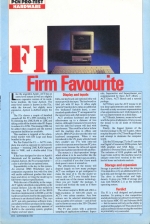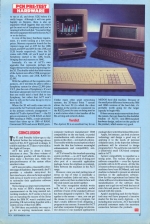
Personal Computer News
 1st September 1984
1st September 1984
Categories: Review: Machine
Author: Ian Scales
Published in Personal Computer News #076
The Apricot Range - Conclusion

The F1 and Portable follow-ups to the Apricot further the technology-drive aspects of the ACT approach to design. It could be said that ACT likes to view itself as the Apple of Europe.
ACT has gone in about a dozen directions at once. The sheer volumne of technological goodies will doubtless impress many a first-time user, while the price/performance of the system offers excellent value.
ACT now provides a reasonably conherent range of machines. Importantly, the F1 provides a valuable entry-level for first-time buyers, who can be kept supplied with extras or maybe even a new machine to rationalise their application software investment.
Networking is an important component. In the wake of IBM's shattering non-announcement on the long awaited networking standard, ACT seems to have an eye on repeating the success of the Sirius (when the IBM PC wasn't available) and providing UK networking hopefuls with a system in lieu of that from IBM.
In 1984 there are probably two ways to go for an aspiring mainstream microcomputer hardware manufacturer: IBM compatibility on the one hand, or partial standardisatin with attractive enhancements on the other - not much of a choice. The trouble with the second option is that it treads the line between meaningful enhancements and compatibility annoyances.
ACT is bound by the standard Operating System problem - as ACT itself admits, software producers get sick of doing port after port of a successful application package, hence the emphasis on compatibility between the machines in the ACT range.
However, once you start putting tons of extas on top of what is essentially a standard machine (infra-red mice, voice input, and so on) there is a limit to how well the total system can be put together.
The voice recognition module works well, but it's not a particularly useful attribute if none of the standard software has been designed to exploit it. The same applies to the mouse - sure, you can get the mouse to work with a program, but that's totally different from designing a program to use a mouse. It seems that ACT and other companies bringing out alternative devices to run standard application packages have somewhat missed the point.
Apple, for instance, can look at current technology and design a good way of applying it to the needs of personal computer users, in the hope that software producers will be attracted to design programs for it. No such hope can exist for a (relatively) small UK-based company such as ACT.
Apricot compatibility is regarded as a strong point. The various Apricots are software-compatible - even the Apricot portable with its LCD screen. All the bits of system software unique to the individual machines have been ROMmed, and each machine is claimed to present an identical interface to the applications software. How far this requirement has limited the whole will have to be determined later. The standardisation of the software does appear not to gel too well with the host of extra bits and pieces ACT has seen fit to include with the system.
Apple's marketing push for the Macintosh may well have prepared a lucrative market for the less costly Apricots - by including mice and icons, ACT has helped potential customers make the necessary connection between the products.
This article was converted to a web page from the following pages of Personal Computer News #076.





